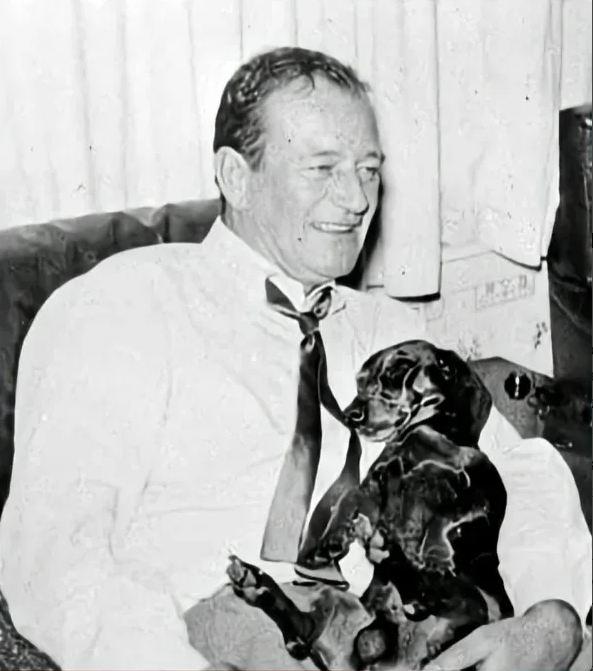
During filming in Mexico, the crew found a badly injured stray dog. In that era, in that place, the solution seemed obvious to many: put it down. End its suffering. Don’t complicate production with a wounded animal.
John Wayne saw it differently.
He gently picked up the dog and declared words that revealed his character: “If you shoot that dog, you’ll have to shoot me too.”
It wasn’t a joke. It was a line in the sand. This dog’s life mattered to him, and he wasn’t going to let convenience or pragmatism end it when there was another option.
He got the dog medical care, named him Chico, and even gave him a few cameos in the film they were shooting. After filming wrapped, Wayne brought Chico home to the U.S. and kept him as part of the family for the rest of his life.
The black and white photograph shows John Wayne sitting casually, dressed in a white shirt and dark tie, smiling broadly while holding Chico—a small dog, possibly a Chihuahua mix or similar breed, sitting contentedly in his lap. Wayne looks genuinely happy, the kind of unguarded joy that comes from being with someone you love. Chico looks comfortable, secure, like he knows he’s home.
This story offers a window into John Wayne’s character that differs from his on-screen persona. On film, he was often the tough cowboy, the war hero, the man who solved problems with fists and guns. But off-screen, he was the man who picked up a wounded stray and declared it was worth saving even if it complicated everything.
“If you shoot that dog, you’ll have to shoot me too.”
That’s not just compassion—it’s conviction. Wayne could have shrugged, walked away, let someone else handle it. No one would have blamed him for not wanting to deal with a wounded stray during a film production. But he saw a life that needed saving and decided it was worth fighting for.
The fact that he gave Chico cameos in the film adds a beautiful layer to this story. Wayne didn’t just save the dog and forget about him—he integrated him into his work, his life, his daily routine. Chico became part of the family in every sense.
After filming wrapped, Wayne brought Chico home. That’s commitment. It would have been easy to find Chico a home in Mexico, to tell himself he’d done his part by saving the dog’s life. But Wayne took him home, made him part of the family, kept him for the rest of his life.
The photograph captures the result of that choice—a movie star and his rescued dog, both looking content with each other. Chico didn’t end up in John Wayne’s lap by accident. He’s there because Wayne refused to let him die, refused to accept that a wounded stray wasn’t worth the effort, refused to prioritize convenience over compassion.
This story challenges our assumptions about what heroism looks like. We think of John Wayne as a war hero, a cowboy, a man who fought villains on screen. But real heroism often looks quieter—like picking up a wounded dog and saying “not on my watch.”
Chico was badly injured when Wayne found him. We don’t know the details of his injuries, but we know they were serious enough that the crew’s first instinct was to put him down. Recovery would require time, money, medical care. Easier to just end it.
But Wayne saw life worth saving. And he used his power—his star status, his resources, his influence—to save it.
That’s what privilege should look like. Not just having resources, but using them to protect the vulnerable. Not just having power, but wielding it on behalf of those who have none.
“If you shoot that dog, you’ll have to shoot me too.”
John Wayne meant it. And Chico lived the rest of his life as proof that sometimes one person’s conviction can change everything. That sometimes refusing to walk away makes all the difference.
The movie they were filming is long since made and released. The scenes with Chico’s cameos are probably barely noticeable to viewers who don’t know the story. But for Chico, those cameos represented something profound: he wasn’t just saved, he was valued. He became part of something. He had a purpose.
And then he went home with John Wayne and lived as a beloved family member. Not as a publicity stunt or a temporary rescue, but as a permanent fixture in Wayne’s life.
The photo shows the result: a rescued dog and the man who refused to let him die, both looking exactly where they belong—together.